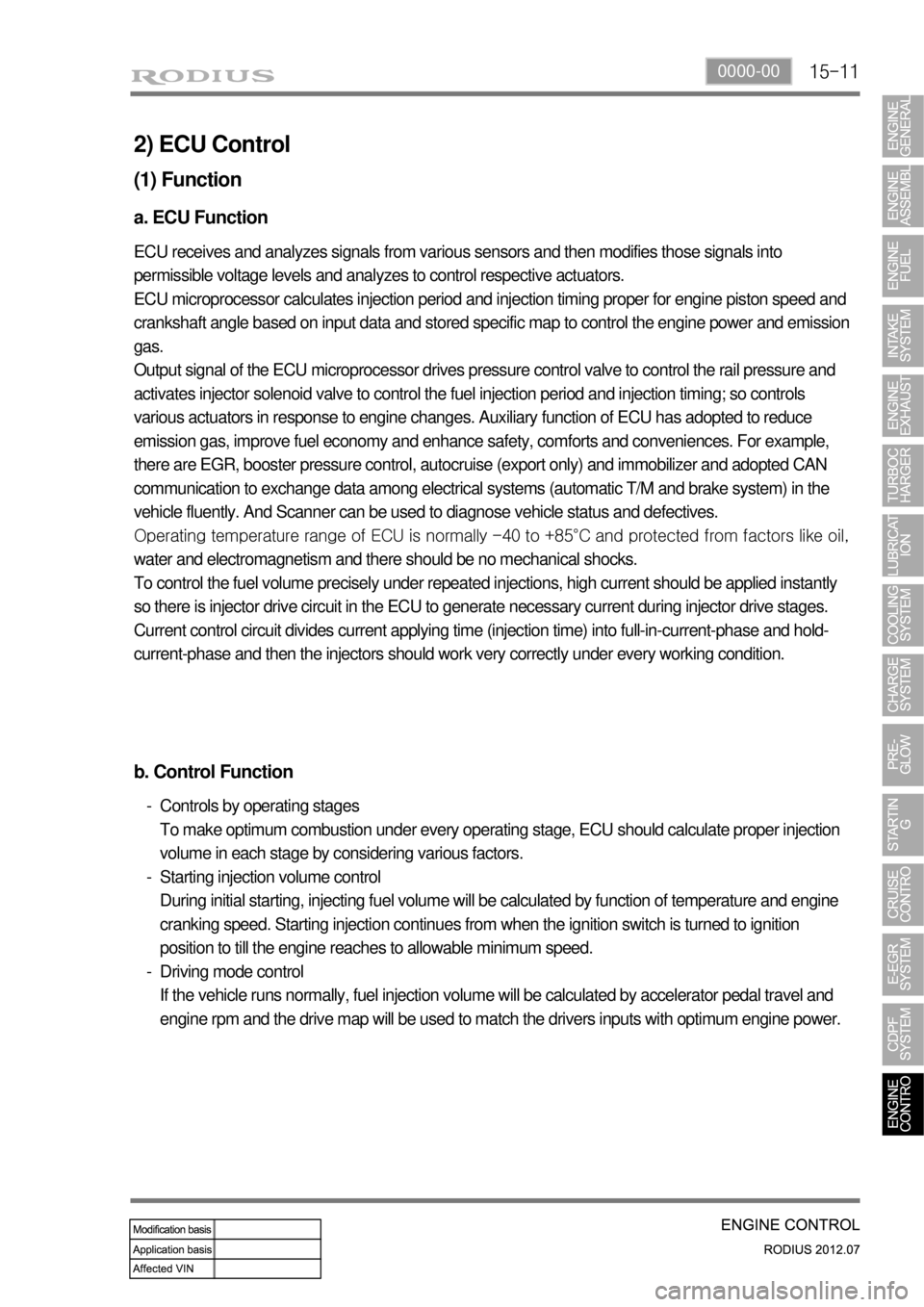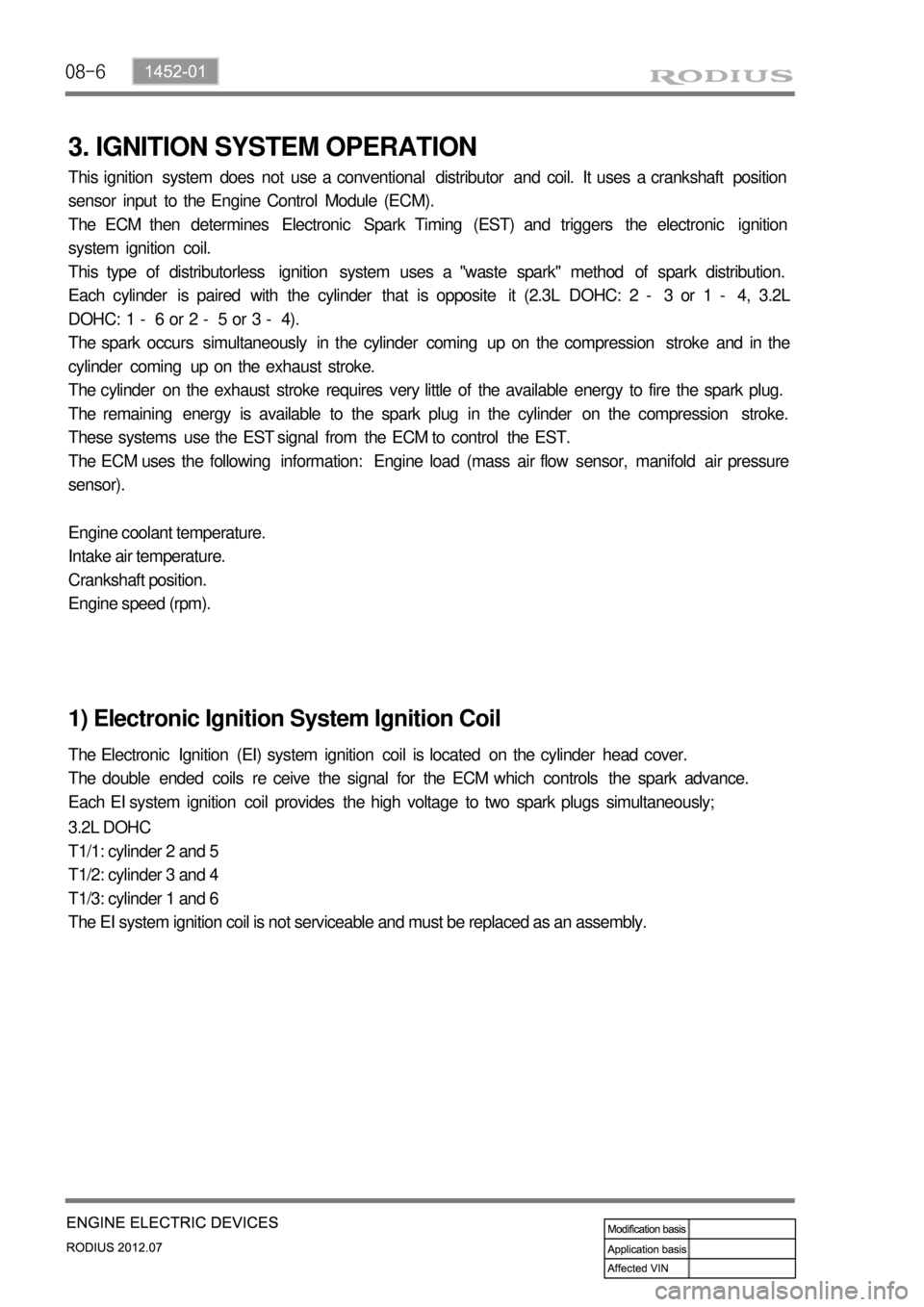Page 266 of 715
07-51543-00
1. SYSTEM DESCRIPTION
1) Overview
The lubrication system supplies oil to each lubrication section to prevent friction and wear and to
remove heat from the friction part. As the engine runs, frictional heat is generated on each
lubrication section. If this condition persists, the bearing can be burned and stuck.
In other words, it creates an oil film on each sliding surface to convert solid friction to liquid
friction in order to minimize wear and prevent temperature increasing on the friction part.
For the D20DTF engine with no oil pressure switch, the engine ECU receives the low engine oil
level signal from the oil level sensor and communicates with the instrument cluster through the
CAN communication to turn on the warning lamp.
2) Components
Oil coolerOil dipstick gaugeOil pump
Oil filter moduleOil pressure switchOil pan
Page 336 of 715

15-110000-00
2) ECU Control
(1) Function
a. ECU Function
ECU receives and analyzes signals from various sensors and then modifies those signals into
permissible voltage levels and analyzes to control respective actuators.
ECU microprocessor calculates injection period and injection timing proper for engine piston speed and
crankshaft angle based on input data and stored specific map to control the engine power and emission
gas.
Output signal of the ECU microprocessor drives pressure control valve to control the rail pressure and
activates injector solenoid valve to control the fuel injection period and injection timing; so controls
various actuators in response to engine changes. Auxiliary function of ECU has adopted to reduce
emission gas, improve fuel economy and enhance safety, comforts and conveniences. For example,
there are EGR, booster pressure control, autocruise (export only) and immobilizer and adopted CAN
communication to exchange data among electrical systems (automatic T/M and brake system) in the
vehicle fluently. And Scanner can be used to diagnose vehicle status and defectives.
<00760097008c00990088009b00900095008e0047009b008c00940097008c00990088009b009c0099008c0047009900880095008e008c00470096008d0047006c006a007c00470090009a0047009500960099009400880093009300a000470054005b005700
47009b009600470052005f005c00b6006a004700880095008b> protected from factors like oil,
water and electromagnetism and there should be no mechanical shocks.
To control the fuel volume precisely under repeated injections, high current should be applied instantly
so there is injector drive circuit in the ECU to generate necessary current during injector drive stages.
Current control circuit divides current applying time (injection time) into full-in-current-phase and hold-
current-phase and then the injectors should work very correctly under every working condition.
b. Control Function
Controls by operating stages
To make optimum combustion under every operating stage, ECU should calculate proper injection
volume in each stage by considering various factors.
Starting injection volume control
During initial starting, injecting fuel volume will be calculated by function of temperature and engine
cranking speed. Starting injection continues from when the ignition switch is turned to ignition
position to till the engine reaches to allowable minimum speed.
Driving mode control
If the vehicle runs normally, fuel injection volume will be calculated by accelerator pedal travel and
engine rpm and the drive map will be used to match the drivers inputs with optimum engine power. -
-
-
Page 365 of 715

15-40
D. Cooling fan and A/C compressor control
Conditions for cooling fan control ▶
The PWM cooling fan is set by coolant temperature and A/C refrigerant pressure. And, the setting value
in A/T equipped vehicle may vary according to the internal oil temperature. The The engine ECU
controls the PWM cooling fan unit based on various signals to get the optimized temperature during
engine running.
PWM cooling fan control according to coolant temperature and vehicle speed -
The PWM cooling fan starts running
from 89℃ of coolant temperature
PWM cooling fan control according to transmission fluid temperature (A/T)
1. PWM duty under 129℃: 0%
2. PWM duty over 130℃: 94.4% -
PWM cooling fan control according to A/C refrigerant pressure -
PWM duty value sharply increases
when the A/C refrigerant pressure goes
over 10 bar. And, it slowly decreases
when A/C refrigerant pressure goes
down below 14 bar (A/C compressor
OFF). PWM duty
Refrigerant pressure
(bar)under 101℃: The PWM duty value
decreases when the vehicle speed
increases
over 105℃: The PWM duty value
is fixed at 94.4% -
-
Page 403 of 715

08-6
3. IGNITION SYSTEM OPERATION
This ignition system does not use a conventional distributor and coil. It uses a crankshaft position
sensor input to the Engine Control Module (ECM).
The ECM then determines Electronic Spark Timing (EST) and triggers the electronic ignition
system ignition coil.
This type of distributorless ignition system uses a "waste spark" method of spark distribution.
Each cylinder is paired with the cylinder that is opposite it (2.3L DOHC: 2 - 3 or 1 - 4, 3.2L
DOHC: 1 - 6 or 2 - 5 or 3 - 4).
The spark occurs simultaneously in the cylinder coming up on the compression stroke and in the
cylinder coming up on the exhaust stroke.
The cylinder on the exhaust stroke requires very little of the available energy to fire the spark plug.
The remaining energy is available to the spark plug in the cylinder on the compression stroke.
These systems use the EST signal from the ECM to control the EST.
The ECM uses the following information: Engine load (mass air flow sensor, manifold air pressure
sensor).
Engine coolant temperature.
Intake air temperature.
Crankshaft position.
Engine speed (rpm).
1) Electronic Ignition System Ignition Coil
The Electronic Ignition (EI) system ignition coil is located on the cylinder head cover.
The double ended coils re ceive the signal for the ECM which controls the spark advance.
Each EI system ignition coil provides the high voltage to two spark plugs simultaneously;
3.2L DOHC
T1/1: cylinder 2 and 5
T1/2: cylinder 3 and 4
T1/3: cylinder 1 and 6
The EI system ignition coil is not serviceable and must be replaced as an assembly.
Page 627 of 715
09-194891-01
▶DUMP (ESP is working) Mode
The pressure decreases just before the wheel speed drops and the wheels are locked.
The inlet valve closes and the outlet valve opens as in the ABS HECU and the oil is gathered at
the low pressure chamber while no additional oil is being supplied. Then the pump operates to
allow fast oil drainage. The shuttle valve and the separation valve do not operate while
decompression.
Page 639 of 715

10-10
▶Pressure Decreases in the Circuit when ABS is Operating
Even when the hydraulic pressure on each circuit is stable, the wheel can be locked as the wheel speed
decreases. This is when the ABS ECU detects the wheel speed and the vehicle speed and gives the
optimized braking without locking the wheels. In order to prevent from hydraulic pressure increases, the
inlet valve is closed and the outlet valve is opened. Also, the oil is sent to the low pressure changer and
the wheel speed increases again. The ABS ECU operates the pump to circulate the oil in the low
pressure chamber to the master cylinder. This may make the driver to feel the brake pedal vibration and
some noises.
▶Pressure Increases in the Circuit when ABS is Operating
<0068009a0047009b008f008c0047009e008f008c008c00930047009a0097008c008c008b004700900095008a0099008c0088009a008c009a00530047009b008f008c0047009000950093008c009b0047009d00880093009d008c004700960097008c009500
9a004700880095008b0047009b008f008c0047009e008f008c>el’s pressure increases due to
the master cylinder pressure. The oil in the low pressure chamber circulates to the wheel by the pump
and the wheel speed decreases as the hydraulic pressure at wheel increases. This operation continues
repetitively until there are no signs that the ECU is locking the wheels. When the ABS hydraulic pressure
control takes place, there may be some vibration and noises at the brake pedal.
Page 642 of 715
11-4
2. TIGHTENING TORQUE
DescriptionKgf·m N·m
Steering column shaftSteering column mounting bolt 2.0 ~ 2.5 19.6 ~ 24.5
Steering wheel and steering column shaft
lock nut4.0 ~ 6.0 39.2 ~ 58.8
Steering wheel and air bag module
mounting bolt0.7 ~ 1.1 6.8 ~ 10.8
Steering column and lower shaft
connection bolt.1.8 ~ 2.5 17.6 ~ 24.5
Power steering gear
boxSteering gear box and gear box cross
member mounting bolt7.0 ~ 9.0 68.6 ~ 88.2
Steering gear box and lower shaft
connection bolt2.5 ~ 3.0 24.5 ~ 29.4
Tie rod end and knuckle connection nut 3.5 ~ 4.5 34.3 ~ 44.1
Tie rod end lock nut 6.5 ~ 8.0 63.7 ~ 78.4
Steering gear box and pressure hose
connection nut3.2 ~ 3.8 31.4 ~ 37.2
Steering gear box and return line
connection nut3.2 ~ 3.8 31.4 ~ 37.2
Power steering pumpEye bolt for oil supply pipe to power
steering pump5.5 ~ 6.5 53.9 ~ 63.7
Power steering pump mounting bolt 2.0 ~ 2.5 19.6 ~ 24.5
Power steering line Return line and clip connection bolt 1.2 ~ 1.8 11.7 ~ 17.6
Page:
< prev 1-8 9-16 17-24